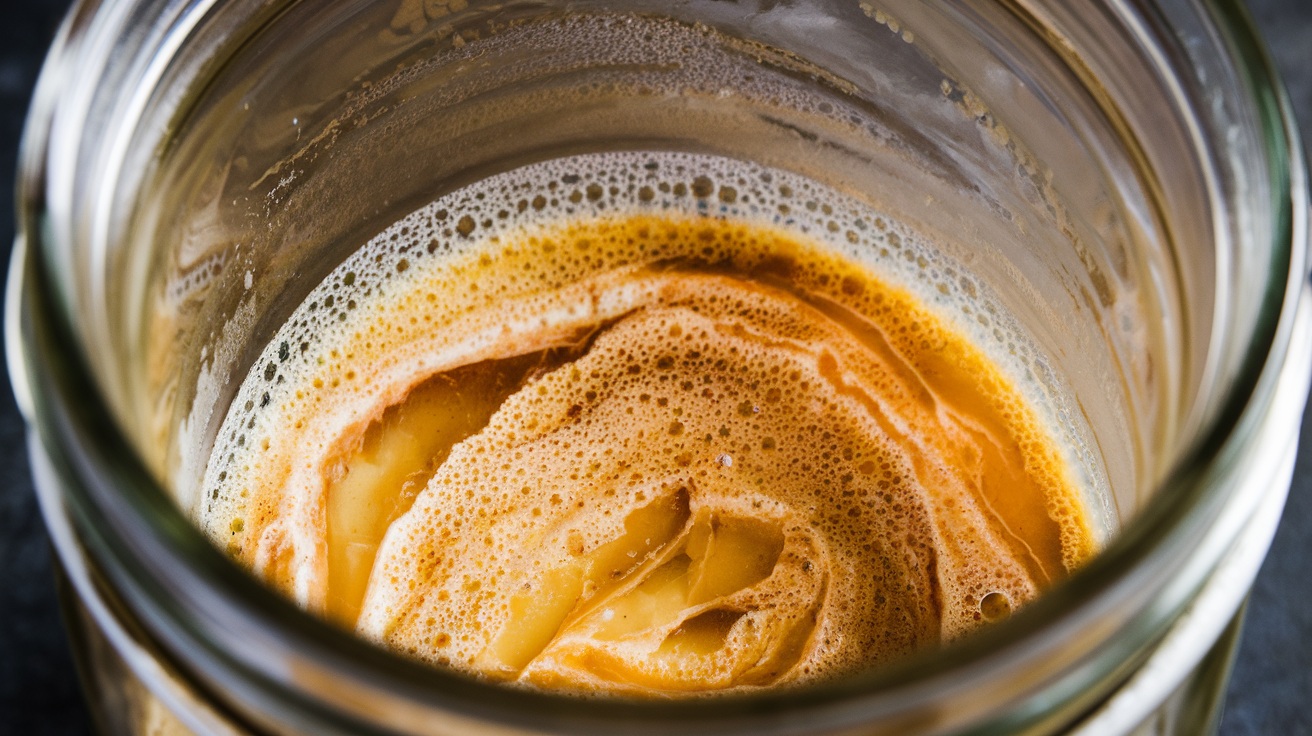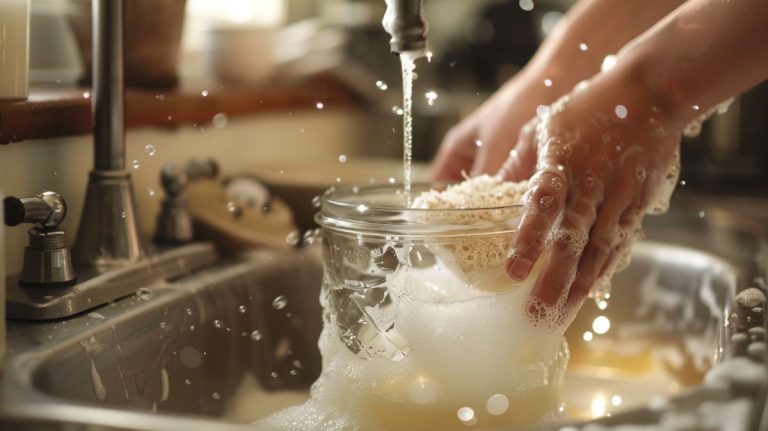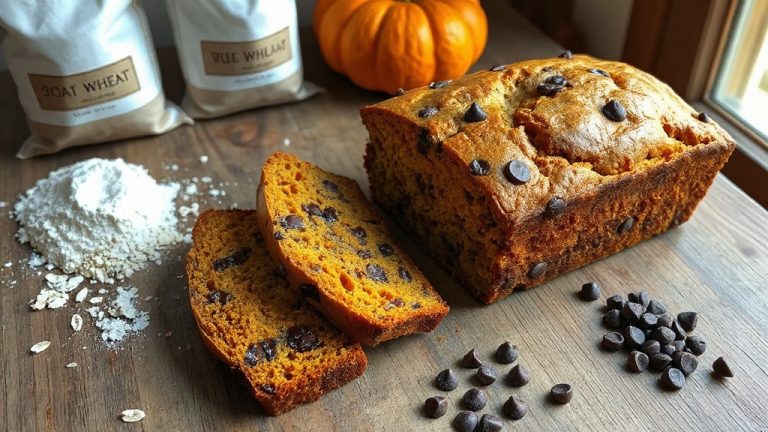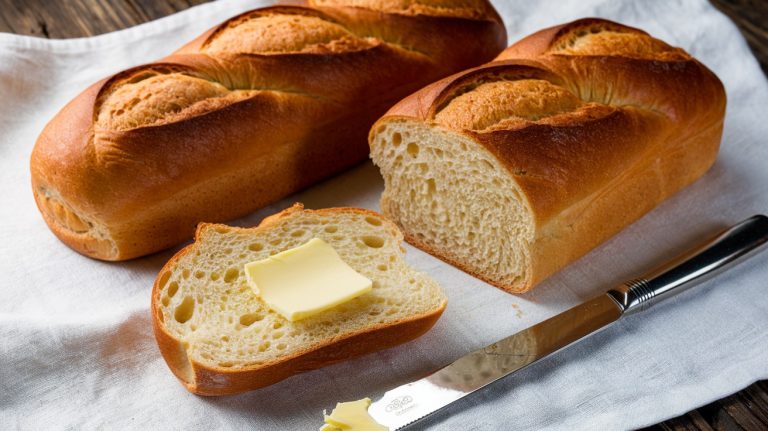Why Does My Sourdough Starter Get a Crust on Top?
Your sourdough starter gets a crust on top due to factors like air exposure, low humidity, and inadequate feeding. When air touches the surface, it leads to oxidation and drying. Low humidity exacerbates moisture loss, causing a hard crust to form.
Regularly feeding your starter helps maintain microbial activity and balance, preventing inactivity and hooch formation. Understanding the intricacies of your environment can enhance starter health, and there are effective strategies to manage and prevent crust issues.
Key Takeaways
- Crust formation occurs due to air exposure, leading to oxidation and drying on the starter’s surface.
- Environmental conditions like low humidity and temperature fluctuations can exacerbate crust development.
- Neglecting regular feedings results in a drier starter, leading to hard crust and loss of microbial activity.
- Proper covering techniques, such as damp towels or plastic wrap, help minimize moisture loss and prevent crust formation.
- Monitoring temperature and humidity is essential for maintaining a healthy fermentation environment and preventing crust issues.
Causes of Crust Formation in Sourdough Starters
When you maintain a sourdough starter, several factors can lead to the formation of a crust on its surface. Environmental conditions, like dry or high-altitude climates, can dry out your starter, while temperature fluctuations can disrupt its activity, accelerating crust formation.
Low humidity levels exacerbate drying, and how you cover your container plays an essential role; loose covers fail to retain moisture effectively. Irregular feeding schedules disrupt the starter’s ecosystem, potentially causing crusting.
Additionally, inconsistent hydration and the type of flour used can affect the starter’s consistency, increasing crust risk. Finally, thicker starters are more prone to drying due to reduced moisture, making regular maintenance essential for a healthy, crust-free starter.
Regular feedings can help keep your starter hydrated and prevent crust formation. To maintain starter health, ensure that you adjust your feeding schedule and monitor its consistency regularly.
The Role of Air Exposure
Crust formation in sourdough starters is greatly influenced by air exposure, which leads to oxidation and drying at the surface. When your starter is kept in a loosely covered container, it becomes more susceptible to excessive air exposure. This can exacerbate crust formation, especially in dry climates. To mitigate this, consider using a lid or plastic wrap that allows for some air exchange while still protecting the starter.
Regular feeding also plays a critical role in maintaining starter health, as it supports active fermentation. Proper covering techniques can enhance starter development and reduce the likelihood of crust formation. Additionally, frequent cleaning of the jar prevents contamination and helps maintain an optimal environment for your starter. Monitoring the starter’s smell can help you identify any issues arising from air exposure.
Impact of Low Humidity on Starter Health
Low humidity greatly impacts your sourdough starter’s moisture balance, leading to a drier, stiffer consistency that can hinder fermentation. As the surface dries out, you face an increased risk of crust formation, which can trap moisture and promote mold growth if not monitored.
Maintaining proper humidity control is essential for keeping your starter healthy and ensuring ideal fermentation rates. High humidity can complicate the fermentation process by creating an environment that is more conducive to mold growth. Additionally, a consistent feeding schedule is crucial for preventing mold growth and ensuring your starter remains active and healthy.
Effects on Moisture Balance
Although maintaining a sourdough starter can be a rewarding endeavor, low humidity poses significant challenges to its moisture balance and overall health. In dry environments, your starter may lose moisture rapidly, leading to dryness that can compromise its activity.
Different flours absorb water differently; whole grain flours retain more moisture than white flours, which can aid in maintaining hydration. Regular feeding is essential, as it keeps the starter active and reduces the risk of dryness. Additionally, controlling the temperature within the ideal range of 24°C to 28°C prevents rapid fermentation that depletes moisture.
Consistent warm temperatures enhance yeast activity and can help mitigate moisture loss. By covering your starter and using high-absorption flours, you can better manage its moisture levels and guarantee a robust, thriving starter. Maintaining continuous refreshments helps to ensure your starter remains lively and hydrated even in low humidity conditions.
Increased Crust Formation Risk
Maintaining proper moisture levels in your sourdough starter is essential, as insufficient humidity can greatly elevate the risk of crust formation. In low-humidity environments, water evaporation accelerates, leading to crust development. To combat this, consider the following:
- Covering: Verify your starter container is adequately covered to minimize air exposure, as this prevents excessive gas production that can lead to crust formation.
- Feeding Frequency: Increase your feeding schedule, especially in dry conditions, to maintain moisture levels and ensure a healthy microbial balance.
- Environmental Monitoring: Keep an eye on ambient temperature and airflow, as these can exacerbate dehydration.
While crust formation doesn’t necessarily indicate poor starter health, it does signal an urgent need for attention to moisture management. Regular stirring and proper covering can help sustain a vibrant, active starter, which can also be supported by maintaining a consistent feeding schedule.
Importance of Humidity Control
Humidity control is essential for the health of your sourdough starter, as it directly influences yeast and bacteria activity. Low humidity slows fermentation, inhibiting microbial growth and leading to a drier, stiffer starter. This reduced moisture affects your starter’s ability to rise, resulting in denser bread. Additionally, the flavor profile may suffer, producing milder sourness.
To counteract these effects, you can increase hydration or adjust the flour type to maintain dough development. Monitoring humidity with a hygrometer allows for timely adjustments, ensuring ideal conditions. Understanding the role of humidity is crucial for achieving consistent results in your sourdough baking, as yeast activity can be significantly impacted by moisture levels.
Regular feeding and maintaining cleanliness are vital, especially in low-humidity environments.
Importance of Regular Feeding
Regular feeding of your sourdough starter is essential for its health and performance, as it directly influences the microbial community responsible for fermentation.
Adhering to a consistent feeding schedule provides numerous benefits:
Consistent feedings ensure a thriving sourdough starter, promoting yeast activity and preventing issues like hooch formation.
- Nutrient Supply: Regular feedings supply necessary nutrients, ensuring yeast and bacteria remain active and bubbly. Additionally, discarding half of the starter before each feeding helps manage microbial balance.
- Preventing Hooch: Frequent feedings help prevent the formation of hooch, a sign of underfeeding that can hinder starter activity.
- Maintaining Activity: Consistent feedings sustain the starter’s activity level, vital for proper bread leavening. Additionally, refrigeration slows yeast activity, allowing for less frequent feedings when the starter is not in use.
Neglecting these feedings can lead to decreased activity, hooch formation, and an unbalanced microbiome, ultimately making it challenging to revive your starter for baking.
Temperature Fluctuations and Their Effects
Temperature fluctuations can considerably disrupt the moisture balance in your sourdough starter, impacting its overall health and crust formation. You’ll want to maintain that ideal temperature range of 24°C to 28°C to guarantee consistent fermentation and moisture retention.
Regularly monitoring the temperature with precise techniques is essential for preventing crust development and keeping your starter active. A sourdough starter should be kept in an optimal temperature range to thrive, as this minimizes stress on the yeast and bacteria. Sourdough starter thrives in a consistent environment, making it crucial to minimize temperature variations to ensure its health.
Impact on Moisture Balance
Although fluctuations in temperature can seem minor, they greatly impact the moisture balance in your sourdough starter. Variability can lead to uneven fermentation and crust formation due to several factors:
- Evaporation Rate: Higher temperatures increase evaporation, causing a drier surface.
- Microbial Metabolism: Temperature changes alter yeast and bacteria activity, affecting moisture retention. Natural yeasts and lactic acid bacteria are critical for the fermentation process and their activity can be impacted by temperature fluctuations. Maintaining a stable environment is essential for optimal microbial activity.
- Humidity Levels: Low humidity exacerbates evaporation, promoting crust development.
Ideal Temperature Range
Managing the moisture balance of your sourdough starter is closely tied to maintaining its ideal temperature range.
The ideal temperature for your starter lies between 24°C and 28°C (75°F to 82°F), where wild yeast and bacteria thrive. If temperatures dip below 21°C (70°F), fermentation slows considerably, risking a halt in activity.
Conversely, exceeding 27°C (80°F) accelerates fermentation, potentially leading to over-proofing. Extreme heat above 49°C (120°F) can kill your yeast entirely. Temperature fluctuations can disrupt the fermentation balance, causing separation and inconsistent activity in your starter.
Consistent temperature control is vital; fluctuations can impact the starter’s health and fermentation speed. Higher temperatures may necessitate more frequent feedings, while lower conditions could extend fermentation time.
Understanding these dynamics helps maintain your sourdough starter’s robustness and productivity, as the wild yeast requires a stable, warm environment to flourish.
Temperature Monitoring Techniques
How can you guarantee your sourdough starter remains healthy amidst temperature fluctuations? Monitoring temperature is essential for maintaining ideal fermentation conditions. Here are three effective techniques:
- Thermometer Use: Regularly check the temperature of your starter and environment to guarantee it stays within the perfect range. Maintaining a temperature of optimal fermentation of 74-86°F is crucial for optimal sourdough performance.
- Proofing Boxes: Utilize proofing boxes to create a consistent temperature, protecting your starter from external fluctuations.
- Oven Light Method: Place your starter in an oven with the light on, providing a warm, draft-free environment conducive to fermentation.
Consequences of Lack of Maintenance
If you neglect your sourdough starter, you’ll likely face several detrimental consequences that can compromise its health and effectiveness.
Exposure to air causes it to dry out and form a hard crust, especially in warm temperatures or dry climates. Inactive starters lose microbial activity, leading to an imbalance that exacerbates crust development. Without regular feeding, the starter may become lifeless and susceptible to bad bacteria growth, indicating a lack of maintenance. Physical changes, like crust formation, signal neglect but don’t necessarily mean the starter is dead.
Neglecting your sourdough starter can lead to crust formation and a decline in microbial activity, compromising its health.
Over time, inadequate care disrupts the natural microbial balance, affecting the starter’s health and fermentative power, which can ultimately lead to inconsistent baking results.
Strategies to Prevent Crust Formation
To prevent crust formation on your sourdough starter, covering it properly is essential. By ensuring minimal oxygen exposure with a tight lid or plastic wrap, you greatly reduce the risk of a dry surface. Additionally, adhering to a regular feeding schedule keeps the starter active and hydrated, further mitigating crust issues. Moisture evaporation can also lead to a dry surface layer, so it’s beneficial to monitor the environment in which your starter is kept.
Cover Your Starter
Why risk crust formation when simple covering strategies can guarantee your sourdough starter thrives?
Properly covering your starter not only minimizes oxygen exposure and contamination but also maintains the necessary humidity and hydration for ideal microbial activity.
Here are three effective covering methods:
- Plastic Wrap: Ideal for containers without lids, it creates a seal while allowing some airflow.
- Damp Towels: These maintain humidity and prevent drying, essential in low-humidity environments.
- Loose Lids: Containers with lids should be loosely covered to balance airflow and moisture retention.
Regular Feeding Schedule
Establishing a regular feeding schedule is essential for maintaining your sourdough starter’s health and preventing crust formation. If you keep your starter at room temperature, daily feedings are typical, while warmer environments may require twice-daily feedings for ideal fermentation. For refrigerated starters, once-a-week feedings suffice.
Adjust your feeding frequency based on the starter’s activity and your fermentation goals. Stick to consistent feeding ratios, like 1:1:1 for a quick rise or 1:4:4 for a slower one, and experiment to find what yields the best texture and flavor. Water quality is also important, as using filtered or spring water can enhance your starter’s fermentation activity.
Effects of Crust on Starter Activity
While crust formation on a sourdough starter may seem innocuous, it can greatly impact the starter’s activity. A crust limits exposure to oxygen and nutrients, which are vital for fermentation. This can lead to reduced activity levels, ultimately hindering your starter’s performance.
Crust formation on a sourdough starter limits essential oxygen and nutrients, hindering its fermentation activity and overall performance.
Here are three specific effects of crust formation:
- Nutrient Uptake: The crust can impede your starter’s ability to absorb essential nutrients from the environment, affecting overall growth.
- Oxygen Limitation: A crust restricts oxygen availability, necessary for the microbial activity that drives fermentation.
- Microbial Health: Although the crust doesn’t drastically alter the microbial balance, neglecting it could compromise the starter’s health. Additionally, the diversity and number of bacteria present in your starter can be affected by crust formation, as it limits their access to necessary resources.
Differences Between Wheat and Rye Starters
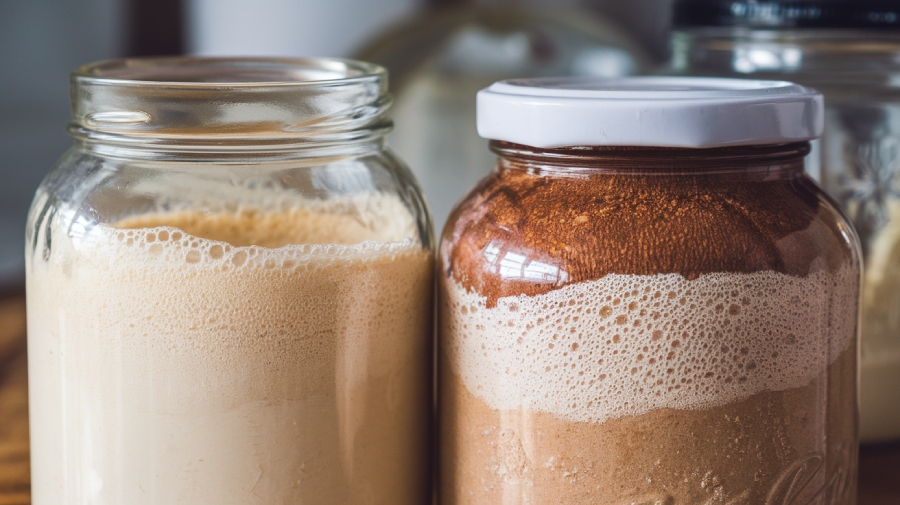
Understanding the differences between wheat and rye starters is essential for any baker aiming to achieve specific fermentation characteristics and flavor profiles.
Rye flour’s lower gluten content results in denser, stickier doughs, while its higher nutrient density and amylase facilitate faster fermentation. The presence of pentosans in rye absorbs water, promoting lactobacilli growth and enhancing sourness. Additionally, rye starters can be converted to wheat in a single build, showcasing their versatility.
Conversely, wheat starters tend to have a milder flavor and require more frequent refreshments to adapt to rye. The fermentation speed varies as well; rye ferments quicker due to its amylase content, while wheat may lag without strong enzymatic activity.
Managing Crust and Hooch Effectively
Choosing the right starter impacts not only the fermentation process but also how you manage crust and hooch on your sourdough.
To effectively control crust formation and hooch, consider these strategies:
- Proper Covering: Use a breathable cover that prevents moisture loss while allowing some air circulation. Avoid overly tight lids that trap moisture.
- Regular Refreshment: Feed your starter consistently to maintain hydration and microbial activity, preventing crust and hooch formation. This regular feeding supports the development of a healthy sourdough starter’s microbial ecosystem.
- Humidity Control: Store your starter in a humid environment to mitigate drying out, especially in arid climates or high altitudes.
Frequently Asked Questions
Can I Still Use My Starter With Crust on Top?
Absolutely, you can still use your starter with a crust on top!
Just gently scrape off the crust before incorporating it into your recipes. The underlying starter remains active and capable of fermentation, contributing to the flavor and texture of your baked goods.
It’s a perfect way to reduce waste while maintaining your starter’s utility.
Just remember to keep it covered or stored properly to minimize future crust formation!
How Often Should I Feed My Sourdough Starter?
You should feed your sourdough starter based on its activity and your baking schedule.
If it’s kept at room temperature, feed it once daily. In warmer conditions or for faster fermentation, consider feeding it twice daily.
If you store it in the refrigerator, once every week or two should suffice.
Always monitor the starter’s behavior, adjusting the feeding frequency as needed to maintain its health and readiness for baking.
What Type of Flour Is Best for Sourdough Starters?
Choosing the right flour for your sourdough starter can feel overwhelming, but it’s essential for success.
All-purpose flour offers a balanced environment, while bread flour enhances gluten development for better structure.
Whole wheat flour accelerates fermentation, and rye flour adds complexity and a unique flavor.
Mixing flours can create a customized starter. Experimenting with different types will help you find what works best for your baking style and desired flavor profile.
Does Temperature Affect the Flavor of My Sourdough?
Yes, temperature greatly affects the flavor of your sourdough. Warmer conditions, around 85-95°F, promote lactic acid bacteria activity, enhancing sourness.
Conversely, cooler temperatures (70-75°F) slow fermentation, resulting in milder flavors and greater complexity.
Ideal yeast and bacterial balance at around 76-78°F fosters a nuanced profile.
How Can I Tell if My Starter Is Healthy?
To determine if your sourdough starter is healthy, observe its bubbles and rise after feeding.
A vigorous starter will double in size within 4-6 hours and exhibit a pleasant tangy smell.
Check the texture; it should be thick yet pourable, with retained bubbles.
Regular activity indicates proper maintenance.
If you see hooch or experience inconsistent rise, it might need more frequent feedings or adjustments to temperature and hydration levels.
A Well-Tended Starter, A Flavorful Reward
To sum up, managing your sourdough starter is like tending to a delicate garden; neglect can lead to a crust that stifles growth. Just as a gardener regularly waters plants to keep them thriving, consistent feeding and proper storage can prevent crust formation.
Remember, a healthy starter yields vibrant, flavorful bread, much like a well-tended garden produces a bountiful harvest. By understanding the factors at play, you can nurture your starter to reach its full potential.

